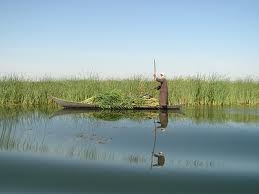Iraq's Mesopotamian Marshlands recovering

Photo credit: http://www.birdlife.org/news/pr/2007/01/iraq_field-guide_launch.html
The Iraqi Marshlands, which were pushed to the brink of extinction
under the Saddam era, are slowly being restored to their former glory
For over 7,000 years the Iraqi Marshland- also known as the Mesopotamian Marshlands- played an important role in global ecosystems by supporting rare wildlife and rich biodiversity. Located in south Iraq, the marshlands stretched to over 6,000 square miles and are believed by many to be the location of the Garden of Eden. In the 1980's, however, Saddam drained the marshland to punish the Marsh Arabs who rebelled against him and turned their green lush wetlands into dusty deserts.
Following the 2003 war in Iraq which had its own destructive impact
on the
environment, a unique opportunity emerged to restore
the marshlands in what has since been dubbed as "the largest
habitat restoration project in the world".
At its peak the Iraqi Marshlands were considered to be the largest wetland ecosystem in the Middle East but after the devastating draining projects under Saddam, the Marshland shrunk to just 10 percent of its original size. The Marsh Arab population dropped from around quarter of a million to just a few thousand.
One Iraqi who had fled the country under Saddam returned to find that the wetlands he knew as a child had been destroyed beyond recognition. Azzam Alwash, decided to change this and set up Nature Iraq to help re-flood and so restore the marshlands.
Water which was diverted away from the Iraqi Marshlands under Saddam were re-routed to the marshlands which has seen the return of reeds on the embankments, bird-life and fishes. Birds such as the pied Kingfisher, the great white Pelican, the Basra Reed Warbler and the Greater Flamingo can now been seen flying across the marshlands.
The restoration has also encouraged the return of Marsh Arabs to the wetlands who are now able to eke out a living from the Marshlands through fishing and making baskets out of reeds to sell in the markets.
This is not to say that the project hasn’t faced any problems. Much of the restoration has been patchy and issues such as falling levels of water and the deteriorating quality of water have hindered a complete restoration. It also means that many Marsh Arabs are still struggling to get back to the living they had before the marshes were drained during the Saddam era.
Those involved in the restoration admit that there is still a long way to go but also point to the current progress as a sign that the Iraqi Marshlands could one day be fully restored to its former glory.
: Image via Nature Iraq
© Copyright 2007 - 2011 Green Prophet